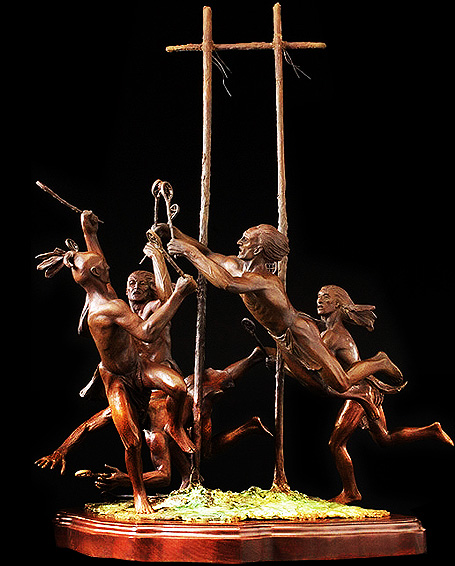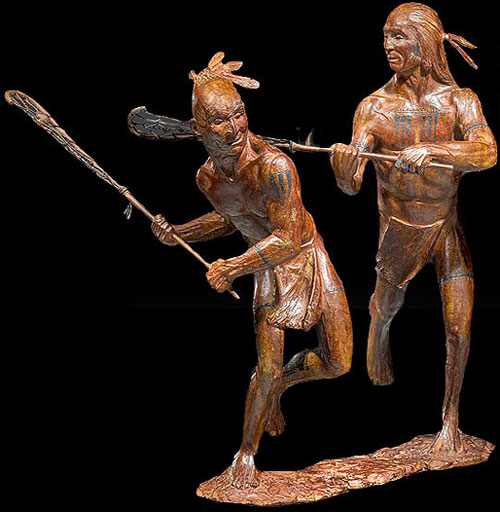Lacrosse – The Creator’s Game
The sport of lacrosse in its original form as played by the Woodland Tribes of the 17th and 18th centuries is a popular theme of Jud Hartmann’s bronzes.
The modern game of lacrosse descends directly from the Iroquois and has its origins in a tribal game played by all eastern Woodlands Native Americans and by some Plains Indians tribes in what is now Canada. Rooted in Native American religion, lacrosse was often played to resolve conflicts, heal the sick, and develop strong, virile men. To Native Americans, lacrosse is still referred to as “The Creator’s Game.”
Shrouded in time, lacrosse was played among the Confederacy long before the coming of the Europeans to the shores of North America. It can be said that when the Europeans first witnessed the sport in the 1630s, (Fr. Jean Brebeuf living among the Hurons in 1636 gave us both the first written account of the game and the name we call it by – lacrosse.) lacrosse was one of the most popular and widespread games played across the continent and with many variations, so with a history that spans centuries, lacrosse is the oldest sport in North America.
“Our grandfather told us that lacrosse was played for the enjoyment of the Great Spirit; everyone was important, no matter how big or small, or how strong or how weak.”
Lacrosse traditionally had many different purposes. Some games were played to settle inter-tribal disputes, a function was essential to keeping the Six Nations of the Iroquois together. Lacrosse was also played to toughen young warriors for combat, for recreation, as part of festivals, and for the bets involved. (Before the game, every player was required to place a wager. Items such as handkerchiefs, knives, trinkets, horses, and even wives and children would be at stake.) Finally, lacrosse was played for religious reasons: “for the pleasure of the Creator” and to collectively pray for something.
Lacrosse was also a mechanism for socialization. It promoted stability in the community by appealing to tradition. Every tribe had its own mythology about the first ball game that was played by the gods of creation. The ball that players volleyed back and forth over the land imitated the sun and the moon that moved back and forth across the sky back in the days when the gods played the game. And so, the players participated in reinforcing the cyclic conception of time common in indigenous America.
Traditional lacrosse games were sometimes major events that could last several days. As many as 100 to 1,000 men from opposing villages or tribes would participate. The games were played in open plains located between the two villages, and the goals could range from 500 yards to 6 miles apart. Rules for these games were decided on the day before. Generally there was no out-of-bounds, and the ball could not be touched with the hands. The goals would be selected as large rocks or trees, and in later years, wooden posts were used. Playing time was often from sun up until sun down.
Like our athletes, the best lacrosse players trained exhaustively and intensely to keep in top shape. But unlike our athletes, they did it in strict isolation. They spent whole days in summer training, running, tumbling, and ball tossing from sun up to sundown to get ready for the customary fall season. To purify themselves, the sequestered warriors followed a special diet which excluded rabbit, a timid animal; frog, because his bones are brittle; and certain kinds of fish that move sluggishly, lest he acquire habits of these animals inimical to the game. Other taboos included consorting with women.
The monumental sculpture is permanently installed at USA Lacrosse / Lacrosse Hall of Fame in Sparks, Md.
USA LACROSSE: MISSION STATEMENT: “As the governing body of lacrosse in the United States, USA Lacrosse provides national leadership, structure and resources to fuel the sports growth and enrich the experience of participants.”


